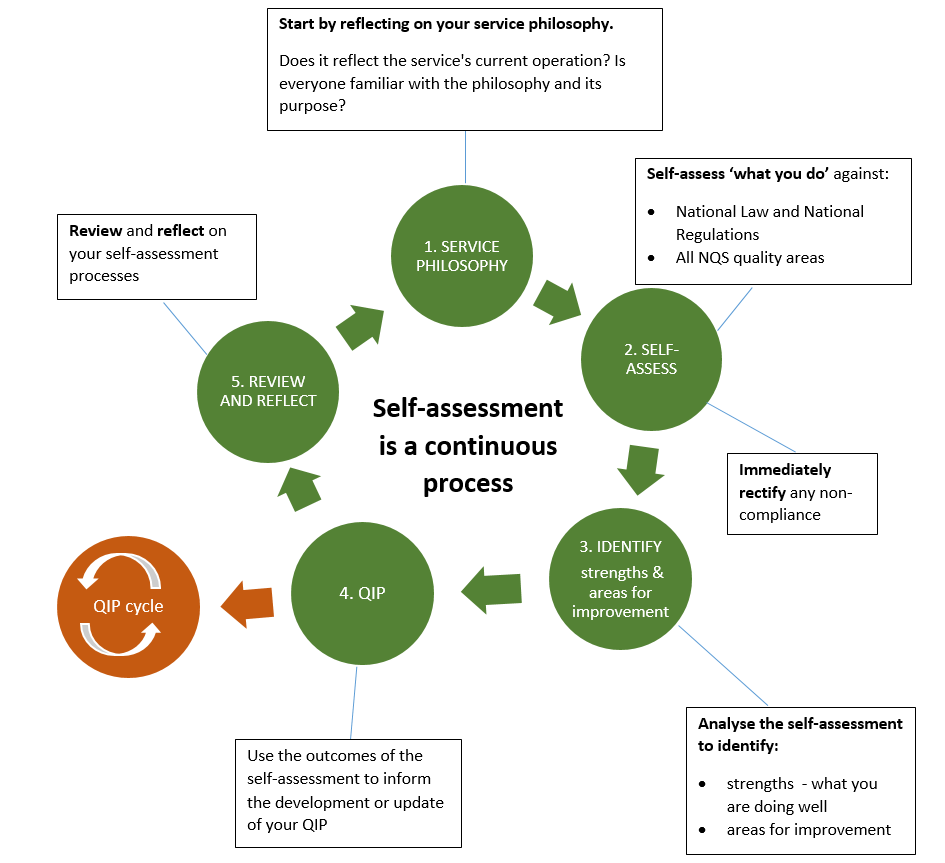Self-assessment is an important process for services to critically reflect on current practice, recognising strengths and identifying opportunities for improvement.
Engaging in self-assessment provides an overall picture of the quality of education and care experienced by children and families attending the service against the NQS, recognises strengths and identifies areas to be improved.
Process Of Self Assessment
Self-assessment involves services analysing ‘what they do’ against the National Law and Regulations and the standards and elements of each NQS quality area. Analysing ‘what they do’ requires reflection and evaluation on service practice, policies and procedures. This reflection and evaluation will support you to confirm legislative compliance requirements are met and whether you consider that you are meeting the NQS.

Consider Your Service
- Review the compliance history at the service and how this can, or should, be considered in self-assessment.
- If applicable, revisit the outcomes of your previous assessment and rating report and rating.
- Consider previous self-assessments.
- Think about the key issues your service has faced or tried to address since your last self-assessment.
- Consider how your service type influences your practice.
- What legislative requirement changes need to be considered?
Know The Standards and Elements of the NQS
- For each quality area, standard and element, descriptors and concepts are provided.
- Reflect on the level of understanding of the quality area as well as the standard and elements in that quality area.
Legislative Requirements
- Confirm compliance or non-compliance against the National Regulations.
- Action to address any identified non-compliance should be recorded and rectified as a priority.
Assessing against the National Quality Standard
- For each Quality Area there will be the opportunity to record evidence against each of the elements within that standard.
When reflecting on the evidence gathered during the self-assessment determine if you consider the element to be met or not.
Identify Strengths and Opportunities for Improvement
- After reviewing the outcomes of your self-assessment against the NQS and legislation it is now time to consider the strengths that have been identified and the areas for quality improvement.
- There is no need to record compliance as a strength unless it is identified that the service is going beyond the minimum requirements.
- For each quality area there is space to identify service strengths for that quality area.
- There is also the opportunity to record the elements/standards that the self-assessment identified as needing improvement or presenting opportunities for quality improvement.
Use the Outcomes of your Self-Assessment to Develop your Quality Improvement Plan (QIP)
• After identifying service strengths and areas for improvement, the summary can be transferred directly into your QIP.
Remember, your self-assessment identifies areas for improvement. Where improvements need to be made, critically reflect on the issues and the way they can be addressed and use your QIP to prioritise these. Your QIP does not need to cover all quality areas, only those where you have identified improvements are needed to meet the NQS.
Celebrate achievements
- Don’t forget to use the QIP as a way of mapping and recording achievements to acknowledge, share and celebrate.
Be Sure to Review and Reflect on your Self-Assessment Processes
- As well as reviewing and reflecting on practice it is important to reflect on and review your self-assessment and quality improvement planning process.
Reflective Questions to Consider for Each NQS Standard
- What practices do we implement that demonstrate this standard?
- How are our practices improving outcomes for children and families?
- How do we demonstrate that our practice is typical for our service?
- How do/could we articulate what informs our practice?
- How do we engage with families and/or the community?
- What, if any, are the areas where we need to take immediate action?
- What are the opportunities for quality improvement?
Use the Outcomes of your Self-Assessment to Develop Your Quality Improvement Plan (QIP)
After identifying service strengths and areas for improvement, the summary can be transferred directly into your QIP. Remember, your self-assessment identifies areas for improvement and your QIP then prioritises these improvements. Your QIP does not need to cover all quality areas, only those where you have identified improvements are needed to meet the NQS.
Self-assessment documentation is not required to be submitted to the regulatory authority. However, the evidence must demonstrate that self-assessment has informed the service QIP.
For more detailed information: Quality Improvement Plan
Reference:
QIP, ACECQA
